Swimming Old
Swimming – Click on Inductee to view Biography
Create Group and ID
1980
- Louis Kuehn - Swimming
-
1980
 Louis Kuehn won the gold medal as part of a sweep of the springboard diving event at the 1920 Antwerp, Belgium, Summer Olympic Games.
Louis Kuehn won the gold medal as part of a sweep of the springboard diving event at the 1920 Antwerp, Belgium, Summer Olympic Games.Born in 1900, Kuehn developed his skills under coach Jack Cody at the Multnomah Athletic Club and was a two-time state diving champion before winning the national championship in 1919. The following year, "Happy" was part of a trio of American men and women who won gold in Olympic diving, a first for the U.S. in the platform and springboard disciplines.
Following the Olympics, Kuehn was a member of the Oregon State University swimming and diving team and assisted in coaching both teams as well.
During World War II, Kuehn served as a swimming instructor for the Navy.
Kuehn was inducted to the Oregon Sports Hall of Fame as part of the inaugural class in 1980.
- Nancy Merki Lees - Swimming
-
1980
 Nancy Merki overcame the effects of polio to become a record-setting swimmer and member of the U.S. team at the 1948 London Summer Olympic Games.
Nancy Merki overcame the effects of polio to become a record-setting swimmer and member of the U.S. team at the 1948 London Summer Olympic Games.Born in 1926, Merki was diagnosed with polio at an early age and took up swimming at age 8 to reduce the effects of the disease, which had caused here to be partially paralyzed at one point. Swimming for the Multnomah Athletic Club and coach Jack Cody, Merki responded fabulously and set national records at distances from 200 to 1,500 meters beginning at age 13. After winning high-point honors at the national championships 1939, Merki was invited to the White House to speak with President Franklin D. Roosevelt, who also suffered from polio.
Along with fellow Olympians Brenda Helser and Suzanne Zimmerman, MAC swimmers, dubbed "Cody's Kids" won 42 individual, 16 relay and three team titles at the U.S. national championships from 1939 to 1948. Merki was the nation's top female swimmer from '39 to '43. In 1944, after she stopped winning freestyle events, she switched to the breaststroke and won yet another national title. She returned to the elite level in freestyle and qualified for the '48 Olympics.
Merki was married shortly before the 1948 Games and competed as Nancy Lees. She reached the final of the 400 freestyle, but did not medal. Between 1939-49, she won 19 individual or relay titles at the national level.
Merki was inducted to the Oregon Sports Hall of Fame in 1980.
- Norman Ross - Swimming
-
1980
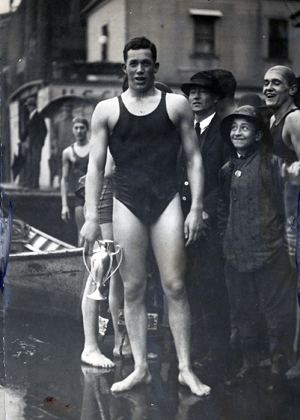 Norman Ross grew up in Portland at the turn of the 20th Century and won three gold medals at the 1920 Antwerp Olympic Summer Games.
Norman Ross grew up in Portland at the turn of the 20th Century and won three gold medals at the 1920 Antwerp Olympic Summer Games.Born in Portland in 1896, Ross matured as a swimmer at the Multnomah Athletic Club under coach Jack Cody. Following a career at Stanford University, Ross qualified for the 1920 Olympics and won the 400-meter freestyle, the 1,500-meter freestyle and anchored the winning 4x200 meter team. The meet took place in an open canal and without lane markings. Ross set 13 world records during his career.
Following the Olympics, Ross moved to Chicago and became a radio personality. He passed away in 1953 at age 57.
Ross was inducted to the Oregon Sports Hall of Fame in the inaugural class of 1980.
- Don Schollander- Swimming
-
1980
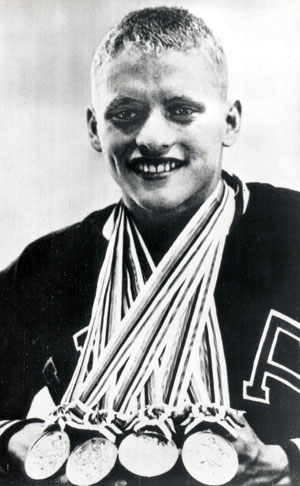 Don Schollander dominated the world of swimming for only a short time, but he did it in such a fashion that he was inducted into the International Swimming Hall of Fame before he turned 20.
Don Schollander dominated the world of swimming for only a short time, but he did it in such a fashion that he was inducted into the International Swimming Hall of Fame before he turned 20.Born in 1946, Schollander grew up in Charlotte, N.C., and then Lake Oswego, where he won two state swimming titles in 1960 as a freshman at Lake Oswego High. Schollander, who grew to be 5-foot-11, won two more individual titles as a sophomore before moving to Santa Clara, Calif., to train with the Santa Clara Swim Club. Two years later, he won three AAU national titles and qualified for two individual and two relays heading into the 1964 Tokyo Olympic Summer Games.
Schollander won gold in all four events, the first time an American had accomplished the feat since Jesse Owens in 1936, and set an Olympic record in three of the events. The U.S. team allowed him to carry the American flag during the Closing Ceremony.
The Associated Press named him Athlete of the Year over Johnny Unitas of the Baltimore Colts, and he was also the recipient of the James Sullivan Award for being the nation’s top amateur athlete, the first time a swimmer won the award.
Following the Games, he attended and swam at Yale University, winning three NCAA event titles. He won a fifth gold medal in a relay at the 1968 Mexico City Games before retiring from competitive swimming.
Schollander returned to Lake Oswego as a real estate developer and raise a family. He wrote two books in the 1970s, including Deep Water, which chronicled the politics of international swimming.
He was inducted into the Oregon Sports Hall of Fame as part of the inaugural class in 1980.
1981
- Brenda Helser - Swimming
-
1981
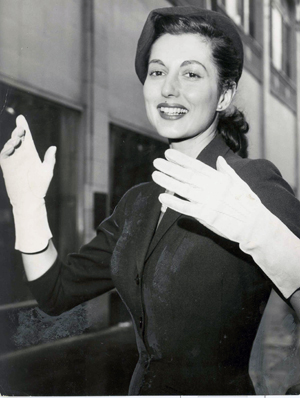 Brenda Helser was part of an outstanding group of young swimmers who represented the Multnomah Athletic Club, and won a gold medal at the 1948 London Summer Olympic Games as part of the 4x100 meter relay team.
Brenda Helser was part of an outstanding group of young swimmers who represented the Multnomah Athletic Club, and won a gold medal at the 1948 London Summer Olympic Games as part of the 4x100 meter relay team.Born in 1926, Helser competed at Stanford University where she graduated in 1946. She then trained under coach Jack Cody, who helped her reach the 1948 Olympics in three events. Helser battled Ann Curtis throughout 1948 for the national record in the 100-meter freestyle, but at the Olympics Curtis won silver, while Helser did not place. Helser, who had moved to Los Angeles, finished fifth in the 400 freestyle, which Curtis won.
Under Cody's guidance, Helser helped the MAC swimmers, who included fellow Olympians Suzanne Zimmerman and Nancy Merki, win 42 individual, 16 relay and three team national titles from 1939 to 1948.
Helser was inducted to the Oregon Sports Hall of Fame in 1981. She is also a member of the Stanford University Hall of Fame.
1983
- Thelma Payne - Swimming
-
1983
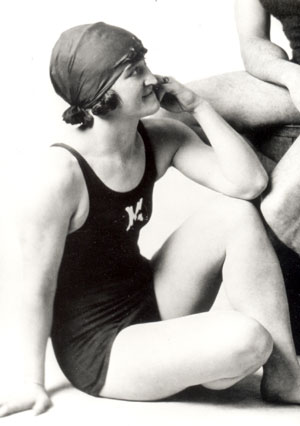 Thelma Payne swam her way to greatness as an Olympic medalist in springboard diving and as an advertising model, one that continues to be famous across the nation.
Thelma Payne swam her way to greatness as an Olympic medalist in springboard diving and as an advertising model, one that continues to be famous across the nation.Payne, later Payne-Sanborn, was born in 1896 and matured in her sport at the Multnomah Athletic Club under coach Jack Cody. She won national diving titles in 1918-20 and competed in the 3-meter event at the Antwerp, Belgium, Olympic Games, the first after World War I and also the first with diving events. She won the bronze.
Following the Games, Payne served as a model for an advertisement being produced for the Jantzen Swim Company, and the image of her turned into the “Diving Girl,” which continues to be connected with the company on its website. Jantzen credits the Diving Girl as being the most widely traveled lady in America due to stickers attached to automobile windows.
Payne moved to Los Angeles in 1926 and coached swimmers there, including several Olympic contenders and the children of many Hollywood stars such as John Wayne.
Payne died in Los Angeles in 1988.
She was inducted to the Oregon Sports Hall of Fame in 1983.
1988
- Suzanne Zimmerman - Swimming
-
1988
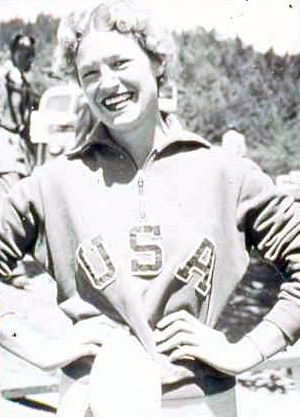 Suzanne Zimmerman won a silver medal at the 1948 London Summer Olympic Games in the 100-meter backstroke and was part of a championship period at the Multnomah Athletic Club.
Suzanne Zimmerman won a silver medal at the 1948 London Summer Olympic Games in the 100-meter backstroke and was part of a championship period at the Multnomah Athletic Club.Born in 1925, Zimmerman swam to national fame while competing under the MAC banner and coach Jack Cody. Along with fellow Olympians Brenda Helser and Nancy Merki, "Cody's Kids" won 42 individual, 16 relay and three national titles from 1939-48. Between 1942 and ’48, she won 15 individual or relay titles at the national level.
Zimmerman was inducted to the Oregon Sports Hall of Fame in 1988.
1989
- Kim Peyton - Swimming
-
1989
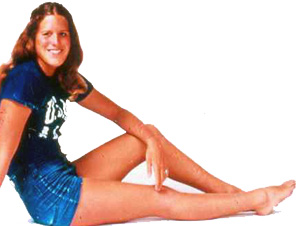 In the 1960s and early ‘70s, Kim Peyton set a standard for women’s swimmers in Oregon, first as a record-setting junior swimmer and then an Olympic Gold Medalist. Born in 1957, Peyton grew up in a family swim environment that included two sisters; Barbara and Kelly, who would eventually win state titles in high school. Kelly continued to the University of Oregon team.
In the 1960s and early ‘70s, Kim Peyton set a standard for women’s swimmers in Oregon, first as a record-setting junior swimmer and then an Olympic Gold Medalist. Born in 1957, Peyton grew up in a family swim environment that included two sisters; Barbara and Kelly, who would eventually win state titles in high school. Kelly continued to the University of Oregon team.She began swimming for the Hood River, Oregon Swim Team the summer before first grade. Kim set three national records as a 9- and 10-year-old before competing for the David Douglas Swim Club and the David Douglas High School Swim Team, which was in the midst of winning 14 consecutive state titles. At David Douglas, she won 14 state titles in freestyle events or as part of a freestyle or medley relay team. Kim Peyton established several state record times starting with the 200 freestyle in 1972, when the swim championships were held in fall. Peyton’s winning time, 1:53.16, lowered the state record by nearly three seconds. In 1975, after the championships were moved to winter, she lowered the record to 1:50.25, which stood until 1994.
Peyton, advanced to the international level in 1971 at the Pan American Games in Cali, Columbia. She won a gold medal in the 200-meter freestyle at age 14. She won four more gold medals – the 100- and 200-freestyle and 4x100 freestyle and medley relays, at the 1975 Pan Am Games in Mexico City.
Peyton, who was on the 1972 U.S. Olympic team, but did not participate in an event, won a gold medal in the 4x100 freestyle at the 1976 Montreal Olympic Summer Games. She met her future husband, Drew McDonald, while swimming for Stanford University. Peyton McDonald died at age 29 of an inoperable brain tumor. She was inducted to the Oregon Sports Fall of Fame in 1989, three years after her death.
1990
- Jack Cody - Swimming
-
1990

During an era of worldwide instability, Jack Cody turned the Multnomah Athletic Club swim program into a national champion and developed a group of girls into a media favorite.
Born in 1885, Cody developed as a diver at the MAC, but made his greatest impact there as a coach of both swimmers and divers starting in 1913. He coached Louis “Hap” Kuehn to gold and Thelma Payne to bronze medals at the 1920 Antwerp Olympics in diving, and worked to develop youth programs at the club. He used weight training as a training method, an unusual theory at the time.
In the late ‘30s, a group of girls reached the national level and became known as “Cody’s Kids,” winning national titles in 1943, ‘44 and again in ‘49. The girls: Nancy Merki, Brenda Helser, Suzanne Zimmerman and Joyce Macrae, were featured in a 1942 issue of LIFE Magazine, appearing in the issue after a photo feature of London, England, following it’s destruction from bombing, and a feature of photos from Japanese planes as they headed for bombing Pearl Harbor the previous winter.
Led by “Cody’s Kids,” who were also joined by Geneva Klaus and Mary Anne Hansen, MAC swimmers won 42 individual and 16 relay titles at the national level. Although they were deprived of fame with the cancellation of the ‘44 Olympics, Helser and Zimmerman competed at the ‘48 Olympic Games in London. Helser won gold as part of the 4x100 meter relay team, and Zimmerman won silver in the 100 backstroke.
Cody’s success with his training program led a generation of swimmers at the MAC to call themselves “Cody’s Kids” long after he retired in 1949 and moved to Los Angeles.
1991
- Della Sehorn - Swimming
-
1991
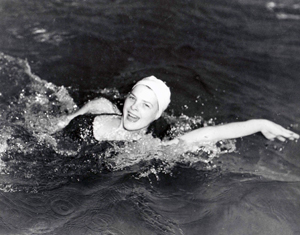 Della Sehorn was among the nation's best in the breaststroke from 1950-53 and a member of the U.S. team at the 1952 Helsinki, Finland, Summer Olympic Games.
Della Sehorn was among the nation's best in the breaststroke from 1950-53 and a member of the U.S. team at the 1952 Helsinki, Finland, Summer Olympic Games.Born in Beaverton in 1927, Sehorn developed her skills through the Columbia Athletic Club and set 18 American records before and after the 1952 Olympics. At age 25, she was the oldest member of the U.S. swim team, but did not reach the Olympic final in the 200 breaststroke.
Upon her return, she was honored with the Bill Hayward Award as the state's top amateur athlete, becoming the first woman to win the award. In 1953, she set three American records on the same day, but retired shortly thereafter to coach.
Sehorn married her club coach, Al Sehorn, and they moved to Los Altos, Calif., where she continued to coach. She returned to competitive swimming in Masters events when the program began in 1970. She was Swimmer of the Year for the Los Altos Masters Swim Team in 1992 after anchoring a 200-meter freestyle mixed (men and women) relay team to first at the World Masters Championships. She swam the lead leg of the 200 medley mixed relay team, which placed second.
Sehorn was inducted to the Oregon Sports Hall of Fame in 1991.
1992
- Carolyn Wood - Swimming
-
1992
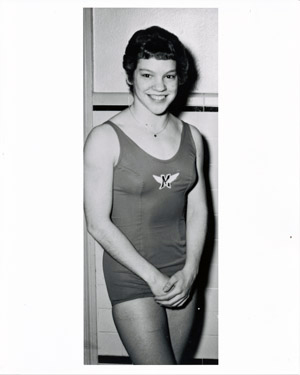 Carolyn Wood won a gold medal at the 1960 Rome Summer Olympic Games in the 4x100 meter freestyle relay at age 14.
Carolyn Wood won a gold medal at the 1960 Rome Summer Olympic Games in the 4x100 meter freestyle relay at age 14.Wood swam under legendary coach Rod Harman at Beaverton High School and won three state titles as a freshman in 1959. She developed her skills, though, largely through the Multnomah Athletic Club, and was among the world's best in the 100 freestyle and 100 butterfly as a high school sophomore. She reached the Olympic final in each, and finished fourth in the 100 freestyle. Wood did not finish the 100 butterfly after accidentally swallowing water on the final turn.
In relays, she swam in a heat of the 4x100 medley relay, and the third leg in the final for the 4x100 freestyle relay, which set a world record by nine seconds.
Wood did not swim in subsequent Olympics after being ruled a professional for working as a lifeguard. She earned a degree at the University of Oregon and became an English teacher and swim coach in Portland. She helped lobby the Tualatin Hills Parks and Recreation District to build a 50-meter pool.
Wood was inducted to the Oregon Sports Hall of Fame in 1992.
2016
- Maureen Murphy - Swimming
-
2016
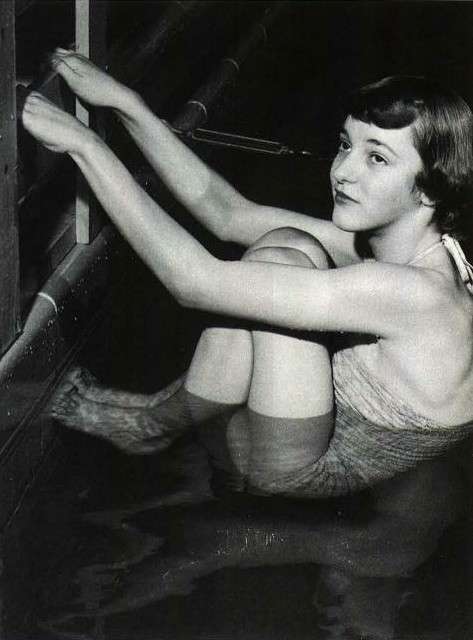 Although her elite-level career was brief, Maureen Murphy helped propel women’s athletics throughout the state by reaching the 1956 Summer Olympic Games. Maureen grew up in Portland and found her way to the Multnomah Athletic Club swim program, where she began to specialize in the backstroke and eventually grew to 5-foot-10. At age 14 and swimming for Holy Child Academy, she won the state high school title in the 100-yard backstroke, then finished second in the 1954 national indoor finals at 200 meters.
Although her elite-level career was brief, Maureen Murphy helped propel women’s athletics throughout the state by reaching the 1956 Summer Olympic Games. Maureen grew up in Portland and found her way to the Multnomah Athletic Club swim program, where she began to specialize in the backstroke and eventually grew to 5-foot-10. At age 14 and swimming for Holy Child Academy, she won the state high school title in the 100-yard backstroke, then finished second in the 1954 national indoor finals at 200 meters.A year later, she lowered the state record in the 100 final by three seconds, then won the national final in the 200 and traveled with a U.S. team as a goodwill ambassador to Europe and the Middle East.
Preparing for the ‘56 Melbourne Games, Maureen finished second in the national 100 finals, then reached the Olympic final, where she placed fifth, missing a medal by less than a second.
He academic career then took over at both Oregon State and Portland State, but her exploits helped girls athletics achieve notice across the state.